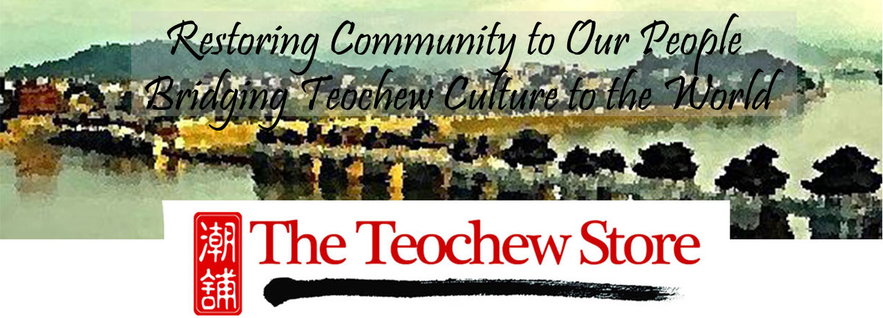The great joy of being a Teochew is the buffet of delicious food that we get to eat. Teochew plain porridge served with pickled vegetable, chai-poh eggs etc etc, char kway teow, braised goose (or duck), steam promfret, pork trotter jelly, all kinds of kuehs… our taste buds are spoilt for choice.

A popular dish for Teochews both in Swatow and overseas is the traditional Teochew oyster omelette or-luak 蠔烙 (literally “pan-fried oysters”). It is simple to prepare, delightful to eat, and certainly needs no introduction. But well, here is anyway a video about a famous or-luak stall in Swatow with 50 years of history:
For anyone inspired to try to serve up a plate yourself, here’s the recipe from allreceipes-Asia :
Ingredients Serves: 4
-
4 eggs
-
2 teaspoons fish or soya sauce
-
2 tablespoons tapioca flour
-
1 tablespoon rice flour
-
2 tablespoons vegetable oil
-
2 cloves garlic, chopped
-
1 teaspoon chilli paste
-
6 to 8 large fresh oysters
-
salt and pepper
-
coriander sprigs
Directions
Prep:10min › Cook:15min › Ready in:25min
-
In a medium bowl, beat the eggs with fish sauce and set aside.
-
Mix the tapioca flour, rice flour and a pinch of salt in 125ml water to make a very thin batter. In a large wok, heat 1 teaspoon oil until smoking hot. Pour in the batter and let it set.
-
Pour the eggs over and when it is almost set, mix everything together. Make a well in the centre by pushing the egg and batter mixture to the sides of the wok. Add the remaining oil and stir in the garlic until fragrant. Add the chilli paste and oysters. Season with salt and pepper to taste. Toss until heated through.
-
Turn onto a serving platter and garnish with coriander sprigs. Serve with bottled chilli sauce mixed with vinegar to taste.
Variations of the or-luak are found in neighbouring southern Fujian (where the Hokkien people live), and the dish is a symbol of the importance of the sea to the lives of the Teochew and Hokkien populations in coastal Southeast China. When the renowned Confucius scholar Han Yu was banished in the 9th century from the Chinese Central Plain by the emperor to become governor of Teochew (at that time a frontier region of the Tang empire), he discovered the Teochew diet of oysters and other exotic seafood and was so fascinated that he composed the poem “Helpful Verses for Yuan Shiba Introducing Food in the South” 《初南食貽元十八協律》to inform his friend Yuan Shiba about them. In what was the prolific poet’s first and only poem with food as the subject, he noted how the Teochews enjoyed food prepared with salty and sour condiments, and dipped in pepper salt, pepper oil and orange sauce (but made him burst into sweat and turned his face red), and confessed that apart from the snake, everything they ate were new to him. For the Teochew people however, the appearance of oysters in our diet traces back even much further.
One day in the late 1950s, an archaeological team from the Guangdong Administrative Committee for Cultural Heritage made an unexpected finding when they chanced upon a shell mound in the remote village of Chenqiao (陳橋), some two kilometres west of Teochew city. Composed of tens of thousands of marine shells, including oyster and clam, it stood at a fairly remarkable height of 1.4 metres. The villagers did not think much of the derelict heap, but for the trained archaeologists this was a treasure trove. Found in many parts of the world near coastlines, lagoons, tidewater flats, rivers and streams, shell middens are not random formations but cultural deposits created by our human forefathers during their transition from the hunter-gathering to sedentary lifestyle 4,000 to 10,000 years ago. As they adapted to living in more confined spaces, their diet was diversified to encompass all everything edible within reach, and shellfish that can be easily collected from shallow waters became an important food source.
And right on cue, investigations at the Chenqiao site unearthed more skeletal remains of cow, pig, deer, fish and turtle (i.e. prehistoric dinner leftovers), and a range of man-made stone and bone tools such as adzes, hatchets, choppers, hammers, pries (for opening the oyster shells) and pottery shards. Even more exciting was the discovery of the fossilised remains of ten human beings, dubbed later by local archaeologists as the “Chenqiao people”. Unfortunately little information has been published about them. Apart from the estimation of their age to be 5,500 and 6,000 years old, it is also reported they included male and female, and young and old, suggesting they were members of a family.
So the next time when you pick up a pair of chopsticks to eat a plate of or-luak, know that you are not indulging in good food, but also continuing a tradition, the Teochew family tradition.
"Like" our Facebook page to stay updated with The Teochew Store.
